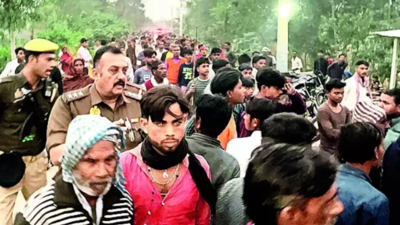The outbreak of foot-and-mouth disease (FMD) in Pilibhit district has significantly affected milch cattle, posing risks to both livestock and humans. The response from the animal husbandry department involves vaccination campaigns and veterinary interventions to control the spread of the disease.
Impact on Livestock
- Approximately 60% of milch cattle in Pilibhit district have been affected by foot-and-mouth disease (FMD).
- Stray cattle are also susceptible to contracting the highly contagious disease.
Vaccination Efforts
- The animal husbandry department has arranged over 3 lakh vaccines to control the spread of FMD.
- These vaccines will be administered to cattle that have not yet been infected.
Transmission to Humans
- Veterinary scientists warn that FMD can be transmitted to humans through the consumption of raw or pasteurized milk from infected cattle.
- Contact with infected animals, particularly during milking, poses a high risk of transmission.
Veterinary Intervention
- Veterinarians, along with para-veterinary workers, are actively involved in the vaccination drive.
- Vaccination is being conducted both at hospital campuses and through door-to-door visits to dairy farms.
Recovery and Treatment
- Cattle infected with FMD may take up to a fortnight to recover with proper medication.
- However, the disease can cause a gradual reduction in milk production, eventually leading to a complete halt.
Concerns and Challenges
- Dairy keepers in Pilibhit express dissatisfaction with the timing of the vaccination drive, suggesting that earlier intervention could have prevented losses.
- Complaints are raised about the inadequacy of treatment provided by government veterinary hospitals, leading cattle owners to resort to expensive private veterinarians.
Multiple Choice Questions (MCQs):
- What percentage of milch cattle in Pilibhit district have been affected by foot-and-mouth disease?
- A) 30%
- B) 50%
- C) 60%
- D) 80%
- Answer: C) 60%
- How is foot-and-mouth disease primarily transmitted to humans?
- A) Through airborne particles
- B) By consuming infected meat
- C) Contact with infected animals
- D) Contaminated water sources
- Answer: C) Contact with infected animals
- What is the primary focus of the vaccination efforts mentioned in the article?
- A) Stray dogs
- B) Wild birds
- C) Milch cattle
- D) Poultry
- Answer: C) Milch cattle
- How long may it take for cattle infected with foot-and-mouth disease to recover with proper medication?
- A) A week
- B) A month
- C) A fortnight
- D) Two days
- Answer: C) A fortnight
- What is one of the concerns raised by dairy keepers in Pilibhit regarding the vaccination drive?
- A) Lack of government support
- B) High vaccine prices
- C) Inadequate vaccine supply
- D) Delayed initiation of the vaccination drive
- Answer: D) Delayed initiation of the vaccination drive
